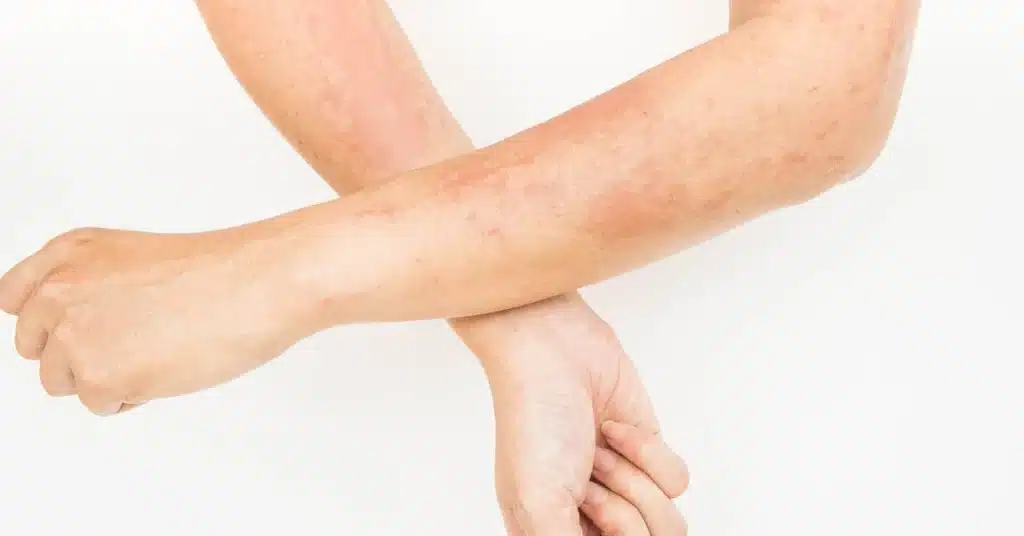Navigating Autoimmune Progesterone Dermatitis: Understanding Symptoms, Causes, and Treatment
Autoimmune Progesterone Dermatitis (APD) is a rare yet intriguing dermatological condition that often goes unrecognized.
It mainly affects individuals, predominantly females, due to an immune response to Progesterone, a hormone present in the female reproductive system.
While the prevalence of APD is low, its impact on affected individuals can be significant, leading to various dermatological symptoms.
In this article, we aim to shed light on APD, its symptoms, causes, diagnosis, and available treatment options.
What is Autoimmune Progesterone Dermatitis
Autoimmune Progesterone Dermatitis is a rare yet increasingly recognized autoimmune disorder characterized by skin reactions triggered by fluctuations in Progesterone levels.
Progesterone is a hormone naturally produced by the ovaries during the menstrual cycle and is crucial for maintaining pregnancy.
In individuals with APD, the immune system erroneously identifies Progesterone as a threat, leading to an inflammatory response that manifests as skin symptoms.
APD most commonly occurs in females in their 30s, and risk increases with the use of Progesterone-only oral contraceptives.
Autoimmune Progesterone Dermatitis symptoms

Recognizing the symptoms of APD is crucial for early diagnosis and effective management.
Symptoms may vary among individuals, but common manifestations include:
- Skin rashes: These can appear as red, itchy patches on the skin and may be widespread or localized
- Urticaria (Hives): Raised, swollen bumps on the skin that are often accompanied by intense itching
- Eczema-like lesions: Dry, scaly patches that may crack, ooze, and cause discomfort
- Systemic symptoms: In severe cases, individuals may experience systemic symptoms such as fatigue, headaches, and nausea
Symptoms tend to worsen during the luteal phase of the menstrual cycle when Progesterone levels are elevated.
What causes Autoimmune Progesterone Dermatitis
The exact cause of APD is not fully understood, but it is believed to result from an abnormal immune response to progesterone.
Hormonal fluctuations during the menstrual cycle or pregnancy can trigger this response, leading to skin inflammation.
Autoimmune Progesterone Dermatitis treatment
Effectively managing APD involves a combination of medications, lifestyle modifications, and natural remedies tailored to the individual’s specific needs.
APD is mainly treated with ovulation suppression.
Treatment options may include:
- Oral and topical Corticosteroids: Reduce inflammation and suppress the immune response
- Antihistamines: Block histamine, mitigating allergic reactions associated with APD and providing relief from symptoms like itching and rash
- Omalizumab: Acts as an antibody, targeting the immune response and potentially reducing allergic manifestations
- Oral contraceptive pill: Regulates hormonal fluctuations, particularly progesterone levels, to manage and prevent flare-ups
- Gonadotrophin-releasing hormones: Modulate hormone levels, impacting the menstrual cycle and Progesterone fluctuations
- Tamoxifen: A selective Estrogen receptor modulator that may help regulate hormonal imbalances
- Oophorectomy: It involves removing one or both the ovaries. This eliminates a major source of Progesterone production, reducing the hormonal trigger
- Progesterone desensitisation: This can be done by injection or intravaginal topical application. It exposes the body to Progesterone, desensitizing the immune response and reducing hypersensitivity
Autoimmune Progesterone Dermatitis typically gets better after Menopause, and doctors avoid prescribing Hormone Replacement Therapy containing Progesterone.
Some women may find relief during pregnancy, as the gradual increase in Progesterone can lead to a natural desensitisation process.
On the other hand, some women may experience worsened symptoms during pregnancy.
Foods to avoid if you have Autoimmune Progesterone Dermatitis

While dietary changes alone may not cure APD, certain foods may exacerbate symptoms or trigger immune responses.
Individuals with APD may consider avoiding the following:
- Foods rich in phytoestrogens: Phytoestrogens can mimic Estrogen in the body, potentially influencing hormonal balance
- Gluten-containing foods: Gluten sensitivity or intolerance may contribute to skin reactions in some cases
- Processed and sugary foods: These may contribute to overall inflammation and exacerbate symptoms
It is important to note that dietary recommendations should be personalized, and consultation with a healthcare professional or nutritionist is advised.
Conclusion
Autoimmune Progesterone Dermatitis (APD) is a rare autoimmune disorder affecting individuals, predominantly females, causing skin reactions due to immune responses to Progesterone.
Though the prevalence is low, the impact on affected individuals is significant, with symptoms like rashes, hives, and Eczema-like lesions.
The exact cause is under research, with hormonal fluctuations being a probable cause.
Management involves a personalized approach with medications, lifestyle adjustments, and dietary modifications.
While dietary changes alone may not cure APD, avoiding certain foods may help alleviate symptoms.
Consultation with healthcare professionals is crucial for tailor-made advice.
Frequently Asked Questions
What is the main cause of Autoimmune Progesterone Dermatitis?
Autoimmune Progesterone Dermatitis is primarily caused by an immune system response against Progesterone, a hormone produced by the ovaries. The exact mechanism triggering this immune reaction is not fully understood, but probable causes include hormonal fluctuations.
What are the treatment options for Autoimmune Progesterone Dermatitis?
Treatment options may include topical steroids, antihistamines, hormonal therapy, and immunosuppressive medications. The choice of treatment depends on the severity of symptoms and individual factors.
Can Autoimmune Progesterone Dermatitis go away on its own?
While some cases of APD may improve on their own, seeking medical attention and implementing appropriate treatment strategies are essential for managing symptoms and preventing complications.
Is Autoimmune Progesterone Dermatitis a common condition?
Autoimmune Progesterone Dermatitis is considered a rare condition. It primarily affects women of reproductive age, and its prevalence may vary. Ongoing research aims to enhance our understanding of this unique autoimmune disorder.
WowRx uses only high-quality sources while writing our articles. Please read our content information policy to know more about how we keep our content reliable and trustworthy.






